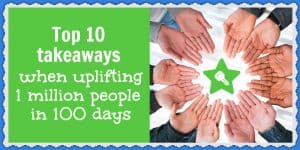As you may already know, my sister and I recently went through a workshop at the ChoiceCenter Leadership University, during which we picked goals that we wanted to work on over the next 100 days.
The experience was phenomenal and we both learned and grew a lot as people and as entrepreneurs.
As part of the training, we took part in a goal setting portion where we made goals for the next 100 days. At first it was tricky for me as I didn’t know what felt compelling to set a goal on. However, I’ve always known I want to help lots of people, so I made a goal of uplifting a million people somehow.
My sister also came up with her own set of goals — 4 to start. But by the end of the 100 days, she had completed not only her initial 4 goals but an additional 9 goals for a total of 13.
The training provided us both with numerous valuable takeaways, many of which can be applied to the Low Hanging System so I thought it could be useful to talk about them below.
It’s one thing to follow the LHS training and get everything set up and operational. But an important part of running a business is setting goals, developing an action plan, and measuring your progress.
Based on the experiences that my sister and I had with Choice, I’m going to share some of the most important insights we gained. And hopefully, you can apply this information to your business so you can make it as successful as you want it to be.
That said, let’s dive in…
1. Ask the right questions.
As I was first shaping how I wanted to achieve my goal of helping one million people, I started asking myself questions. My answers to those questions steered me toward the creation of an action plan.
My questions started out broad – like, “How can I somehow help uplift one million people?”
Asking the right things helps a lot. I think it’s Tony Robbins who says “ask quality questions, have a higher quality life”.
These questions also helped me close the “gaps” in my plan. Thinking critically made me consider various scenarios like, “What if this happens? Or what if that occurs? How would I handle this situation?” etc.
Ultimately, I wanted to make it inevitable that I would help one million people. I didn’t want there to be any doubt that I could make it happen. So the main question I kept going back to was “How can I make it inevitable that I help one million people?”
This is the same type of question I ask myself – and I’d encourage you to ask – when working on LHS. “How can I make it inevitable that I get results?”
Answers to this question will obviously vary, but possible responses could be… “I will use all of the resources I have available to me” or “I will prioritize X amount of time each day or each week to work on my business.”
2. Get support.
With most things in life, having support is key. As I mentioned earlier, when I first got started with Choice, I didn’t know what direction to take. But I had a coach and other people to bounce ideas off of, and that helped immensely.
I needed a concrete way to figure out how I could help one million people. And so, I had someone help me frame that goal in a way that made sense and was actionable. And what I did was work with an assistant who looked at a variety of charities and assessed how many people would be supported for every $1 that was spent.
We created a spreadsheet to help evaluate a ton of charities and then wrote down each organization’s name, mission, website, contact information, and its impact in terms of the number of people who would be helped per $1 spent. This helped me arrive at Feeding America, which provides up to 10 meals for families for every $1 that’s donated. We triple-confirmed with them that we could reasonably estimate that for every $1 donated, 10 people would be supported.
The same assistant who helped find Feeding America also had the great idea to work with DonorsChoose, which is a nonprofit that works with teachers to fund supplies for their classrooms for various projects.
Ultimately, FeedingAmerica and DonorsChoose were the two biggest places we served in terms of impact.
With LHS, there are several ways that you can get support. You can use the Facebook group, talk to a coach (where applicable), or reach out to friends and family and run design ideas by them or let them know when you list new products.
3. Make an action plan and work it.
This is a super important step and something that was definitely stressed with Choice. While it’s impossible to say for sure how your plan will turn out, you don’t ever want to fly completely blind with your goals.
I know I always say the Low Hanging System is a number’s game and a big part of the process is throwing spaghetti at the wall. But that doesn’t mean you shouldn’t have an action plan.
You’re not going to know with any certainty which designs are going to be winners, and that’s why you want to create lots of designs and list as many products as you can. You may want to promote your products as well in order to optimize their traffic and sales.
And as you set out to accomplish these things, it’s really helpful to have a plan of attack. For example…
- I will create X amount of new designs each day/week.
- I will list X amount of new products each day/week.
- I will designate X amount of time each day for customer service.
- I will promote my products in X, Y, and Z ways each day/week.
- Et cetera.
Having daily/weekly goals and to-do lists for yourself helps ensure that you’re continuously making progress so you don’t get stagnant.
To help you stay organized, I wrote a post a while back that included a free design calculator. You can use this calculator to figure out the number of designs you need to make each day in order to reach your target design number by your specified target end date.
For example, say you want to create 300 new designs by the end of the year. With this calculator, you can input those metrics and the calculator will tell you the number of designs you need to make from now until then to meet your goal.
You can check out the calculator here. It’s an easy way to create an action plan and hold yourself accountable (more on that below).
And for more on action plans, I wrote this book a while ago that might be very useful for you.
4. Have built-in accountability checkpoints.
Having accountability checkpoints is another super important thing to do. You need to have an action plan, but you also need to check in every so often to make sure your plan is still on track and serving you well.
It’s all too easy to commit to a certain goal or workload (e.g. posting 10 new designs and listings a day) and then fall off the wagon as life gets busy or you become less motivated. And if you don’t have any predetermined accountability checkpoints, it’s harder to get back on track.
With LHS, your accountability checkpoints could be weekly coaching calls or your interactions in the Facebook group. You could also tell a friend or family member what you’re working on and ask them to check in with you every week or so to make sure you’re still making progress.
This is helpful because, generally speaking, we don’t like feeling as if we’re letting people down. And so, if someone asks how your work is going, you want to be able to honestly say it’s going great! So when you have an outside source tracking your progress, you’re more likely to continue pushing forward than if you were working entirely on your own.
5. Get other people on board or connect with like-minded people.
This relates to #4. The journey toward goal-fulfillment feels a lot less stressful and a lot more motivating when you’re not alone. Having people rooting for you and supporting you makes the tough times more manageable and the successes more fulfilling.
Not everyone in your life is going to understand what you’re doing or why it means a lot to you, though. So it’s helpful to connect with like-minded people or fellow entrepreneurs who get where you’re coming from.
That’s one of the biggest reasons that Choice was such an amazing experience for both my sister and myself. We were surrounded by other people who were also going through the training so there was a “we’re in this together” mentality. And being a part of a community that was accepting and encouraging was hugely helpful at keeping our goals on track.
It’s similar in the Low Hanging System Facebook group. All of the active members in that group are ready, willing, and able to lend support and encouragement and offer advice. It’s no wonder why so many people say the Facebook group is the most valuable resource that’s included with LHS.
So if you haven’t yet joined or participated in the Facebook group yet, I would strongly encourage you to do so.
6. Work smarter, not harder.
This is a universal concept to which you want to aspire. In the context of the Low Hanging System, you especially want to apply the idea of “work smarter, not harder” to your design creation.
One of the main points I stress is that simple, text-based designs sell. Your designs don’t need to be fancy. They don’t need to include a lot of intricate images. And you definitely don’t need to enlist the help of a graphic designer.
Your focus should be on creating as many simple designs as you can and then crafting keyword-rich titles and descriptions for your products’ listings.
I also strongly suggest creating text-based design concepts that you can apply to a variety of niches. I’ve written about this in the past, and it’s one of the best ways for you to work smarter, not harder. You can learn more about what I mean here.
7. Have a reason “why.”
It’s not enough to simply create a goal. That goal has to resonate with you personally. You need to feel an emotional connection to it.
For example, the goal I came up with for Choice is one that feels very near and dear to my heart. I feel strongly that it’s one of my life’s purposes to help as many people as I can. And so, working towards fulfilling that goal felt very rewarding and important to me.
With LHS, many people want to start a business not only to earn more money but also because of what having that additional income could mean to them and their families.
For some people, that additional income could help them put money away for their children’s college education. Or it could be a way for them to work fewer hours at their day job so they can spend more time at home. Or it could provide them with a means of taking a much-needed vacation.
Whatever the case may be, when your reason “why” means something to you personally, you’re more likely to follow through and complete your goals.
8. Expand your emotional awareness.
A big part of the leadership training we went through focused on emotional awareness and developing the ability to identify and name your emotions.
The program talked a lot about how you want to harness your emotions and apply them to thinking and problem-solving tasks. You don’t want your emotions to get the better of you. Part of being an effective leader is learning how to manage your emotions when necessary and helping others to do the same.
This takeaway is more of a general life skill. But with any goal you undertake, including your LHS business, circumstances are always going to arise that test your resolve. And your mindset plays a crucial role when it comes to determining the outcome of those trying situations.
9. Learn to value yourself.
All too many people experience self-doubt and fear. They underestimate their abilities. And as a result, they don’t take action toward fulfilling their goals.
But another super important takeaway from Choice is that you are the creator of your own worth and value, not anyone else. This lesson is tough to put into practice. But it is so important because when you don’t value or believe in yourself, other people aren’t going to value or believe in you either. And most people are capable of far more than they believe.
I truly believe that LHS is a program that can work for anyone, no matter their skill or experience level. And if you are experiencing self-doubt or fear about whether or not you’ll be able to succeed, know that you are not alone and you absolutely are capable of achieving your goals. You just have to learn to value yourself and your abilities and trust that you are more than capable.
10. Cultivate a growth-oriented mindset.
I touched on this in #8. But your mindset really is one of your most important assets. Your perception is your reality. And you are responsible for how you view each situation that you find yourself in.
If a problem arises, you can choose to be offended, saddened, or angered. Or you can choose to see the event as an opportunity for growth.
Especially when you’re building and running your own business, there are going to be snafus from time to time. And when that happens, you can choose to feel frustrated or discouraged and you can even choose to quit.
But that’s not your only option. You can also choose to persevere, seek support, and grow from the difficult situation you’re in. It really is a choice. And it isn’t always easy to choose the latter. But when you do, it can make all the difference between success and failure.
What are your thoughts on what my sister and I learned and how it was implemented via the million person goal? Please leave your feedback in the comments section below. And if you enjoyed this post, please consider sharing it with your friends!






1 thought on “Top 10 takeaways when uplifting 1 million people in 100 days”
This post really spoke to me. I have been spinning in place for too long. Now I am motivated to change this! I am going to work on my plan of action today!